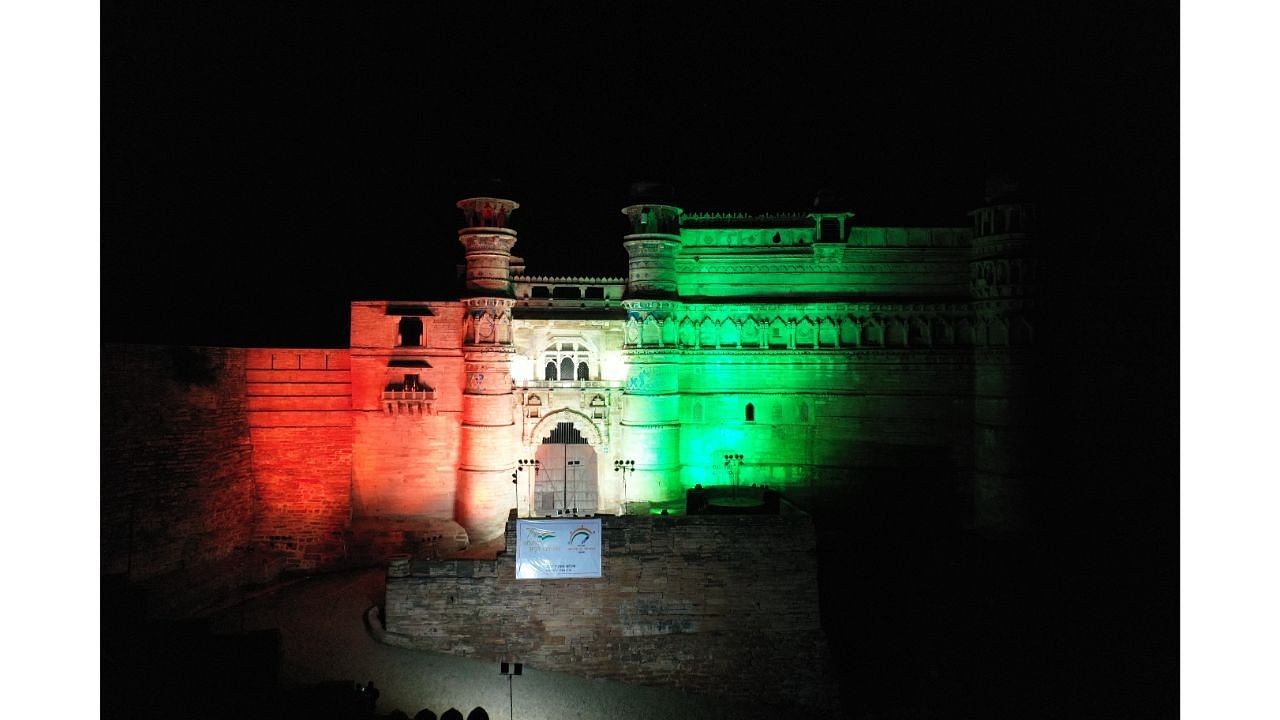
Gwalior Fort in Gwalior, Madhya Pradesh.
Credit: MHA
Bhopal: In a significant boost to its rich cultural and historical legacy, 6 new sites from Madhya Pradesh have found place in the tentative UNESCO list of World Heritage Sites (WHS).
Earlier 4 sites were included in 2021, bringing the total sites to 10 under this tentative list by March 2024. Besides, 3 sites from MP are already included in UNESCO's permanent list. State chief minister Dr Mohan Yadav while expressing happiness also remarked the selection and induction of these sites was a new milestone achievement for India and its glorious past.
Principal Secretary Tourism and Culture Sheo Shekhar Shukla said that UNESCO has included 6 tourist places of MP in its tentative list. These include Gwalior Fort, the historical Dhamnar rock-cut caves and Bhojeshwar Mahadev Temple in Bhojpur, the rock art site of Chambal valley, Kundi Bhandara in Burhanpur, Ramnagar and Mandla Gond sites.
Shukla maintained that all efforts are being made to carve a niche by putting these heritage sites on the international landscape to attract travellers.
The inclusion on UNESCO's list will increase awareness about these destinations, and in turn, drive up the number of tourists and bestow global recognition. He added the process of nomination of these historical sites was carried by the MP Tourism Board.
The proposal, consisting of 9 potential sites in MP, was submitted to UNESCO by the MP Tourism Board. After examining these proposals, UNESCO has approved 6 historical heritage sites.
The remaining 3 heritage sites have been redirected for consideration under the 'serial nomination' clause and the MP Tourism Board is working on this. Shukla said, "We are happy to share that India’s permanent delegation to UNESCO has informed us that proposal submitted by MP (India) was accepted and 6 sites added in the Tentative list of UNESCO in March 2024."
Earlier, UNESCO had selected Gwalior and Orchha of MP in the list of South Asia destinations under the ‘Historic Urban Landscape’ category for nomination and presented its report. This maiden feat is set to be included in the Master Plan of these two cities on MP.
Gwalior Fort
Known for its impenetrable walls, the fortress is situated on the hilltop, from where the beautiful city’s surrounding can be easily viewed and surveiled. With a 10-meter-high wall surrounding the premises, the fort encompasses adorable and exquisite sculptures and remarkable feats of architecture in its construction.
According to historians, the first foundation of Gwalior Fort was laid by Rajput warrior Suraj Sen in the 6th century AD. Following the chequered history of invasion, defeat and conquest, the famous Tomar ruler, Maan Singh, reigned over the Fort in 1398 and built many monuments inside fort premises.
Dhamnar caves
The Dhamnar caves are located in Dhamnar village of Mandsaur district. The rock-cut temple site has 51 caves, stupas, chaityas, passages and dense dwellings and was built in the 7th century AD. The site contains a colossal statue of Gautam Buddha in the nirvana pose. There are 14 historically important caves on the northern bank, of which Bari Kacheri (large courtyard) and Bhima Bazar are more popular with tourists. The Badi Kacheri is 20 feet square and comprises a Stupa and Chaitya. The veranda includes a stone railing and wooden architecture.
Bhojeshwar Mahadev Temple, Bhojpur
Located about 28 km from the capital city of Bhopal, the Bhojeshwar temple is dedicated to Lord Shiva. Carved from a single stone, the huge Linga in the sanctum sanctorum is 2.35 meter long with a circumference of about 6 meters. It is set on a 3-tier sandstone platform in 6 meters square. Due to magnificent architecture, it was given the title of ‘Somnath of East’. Raja Bhoj ordered construction between 1010 and 1053 AD on the hilltop in Bhojpur village, however the temple never seems to have been completed.
Rock Art Site of the Chambal Valley
The world’s largest concentration of rock art sites in the Chambal basin and central India is produced from different historical periods and civilizations. Spread across MP, Rajasthan and Uttar Pradesh, these sites offer insight into ancient human habitation and cultural development.
Stretching from the Paleolithic to the historical period, the rock art depicts scenes of daily life, religious rituals and hunting practices and other depictions of pre-historic human life. The rock art sites in the Chambal basin display a mix of artistic styles and cultural influences, reflecting the dynamic history of the region.
Khooni Bhandara, Burhanpur
A unique, one-of-a-kind water supply system 'Khooni' or 'Kundi Bhandara' is located in Burhanpur. Built about 407 years ago, the system is still operational today and is used by people in the area. It was built by erstwhile ruler Abdurrahim Khankhana in 1615.
Gond Statue, Mandla
Ramnagar in Mandla district used to be the stronghold of the Gond rulers. In 1667, the Gond king, Hriday Shah, built Moti Mahal on the bank of river Narmada. Despite limited resources and technology, the five-storied palace was built as a manifestation of the strong willpower of the king. Over a period of time, two floors have sunk beneath the ground, but the three upper floors can still be seen today.